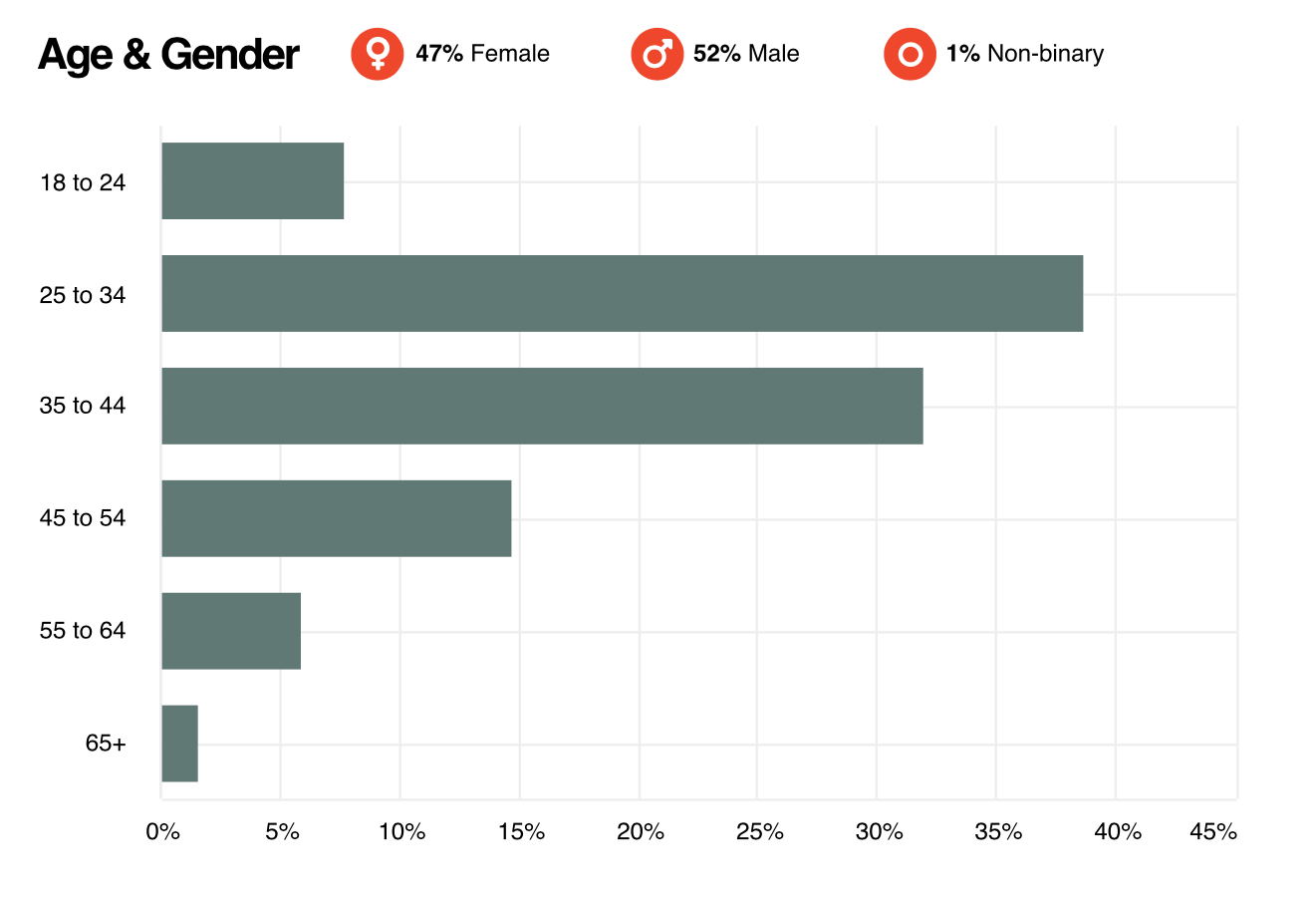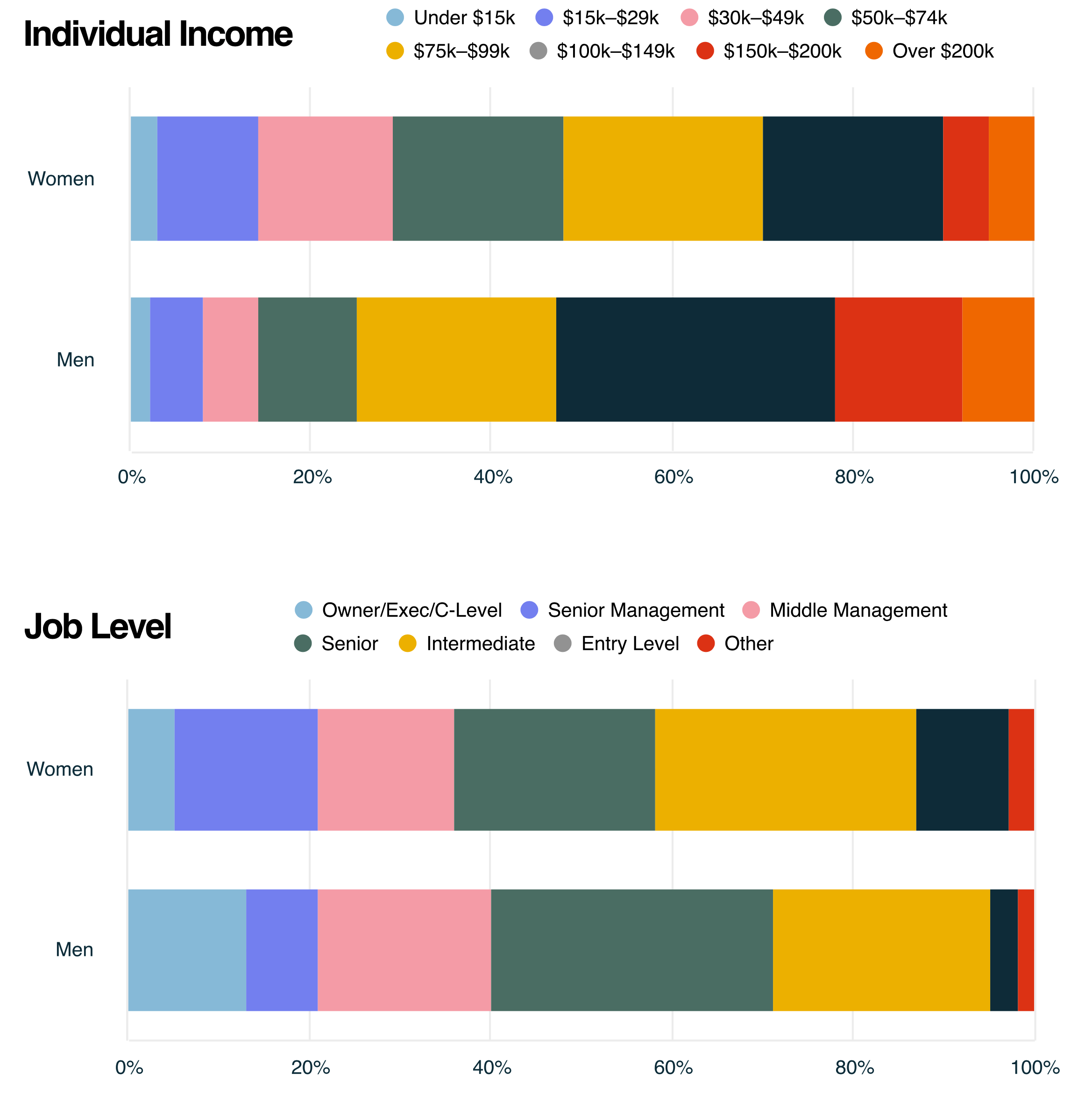Springfield Tech Industry Workplace Survey Report 2023
Presented by Springfield Women in Technology and the Springfield Tech Council. Additionally sponsored by CNH Reman, SRC, Jack Henry, Bass Pro, Legacy Bank & Trust, JMARK, Midwestern, Mostly Serious, and Pitt Technology Group. A research summary of tech worker experiences and attitudes in Southwest Missouri prepared by Habitat Communication Culture.
Springfield Tech Council is excited to finally share insights from the 2023 Tech Workplace Survey Report. This research provides crucial takeaways for tech employers in southwest Missouri, highlighting key strategies for attracting and retaining talent in our rapidly evolving industry.
Here's a peek into the findings:
Compensation and Flexibility Matter: The report underscores the importance of total compensation packages and work flexibility. To remain competitive in the race for talent, we need to prioritize these aspects.
Development Opportunities: The survey revealed that women in tech are particularly interested in mentoring programs, professional training, and continuing education. It's time to invest more in these areas to ensure our workforce feels valued and empowered.
Addressing Workplace Barriers: The report brings to light the persistent issue of workplace discrimination, particularly among local female tech employees. We need to tackle these barriers head-on to create a welcoming, inclusive environment.
The call to action is clear: we must build cultures that attract diverse talent and create welcoming, supportive environments for all. Establishing such a culture will not only secure top tech talent but also give businesses a competitive edge.
We encourage you to dive into the report, absorb its contents, and share the findings with your team - start a dialogue that matters. But let's not stop at discussion. Let's take it a step further by turning these insights into actionable initiatives that will pave the way for a more balanced tech landscape in Springfield. It's all about creating a nurturing environment where every single one of us can grow and reach our full potential.
A warm thank you to everyone involved in this project. Let’s take a moment to recognize the progress we’ve made together, and remember there’s always room for improvement. Together, we can make Tech in Springfield the best it can be. Your hard work and dedication inspire us all.
Read the full report below or watch a video presentation of the findings.
Research Project Overview
What We Set Out to Learn
The disparity between men and women in the tech industry (or in technical roles) is well-documented. A 2021 report by McKinsey1, for example, concludes that women hold only 34% of entry-level engineering and product roles, and just 26% of all first-level management positions. Similarly, the National Center for Women and Information Technology2 reports that, in 2021, only 26% of all professional computing jobs in the United States were held by women. And, research conducted in 20223.
suggests that women are 65% more likely to be laid off than men in the tech industry. Such data paints a bleak picture for women looking to make a career in the tech industry, nationally. At local levels, though, it’s possible that women have more positive experiences in tech-related roles.
In early 2023, SGF Women in Tech, an interest group located in Springfield, MO, set out to better understand the lived experiences of women and gender minorities who are part of southwest Missouri’s tech workforce.
Key Learning Objectives
This research examined Southwest MO tech workers’ experiences including employment preferences, professional development, and socio-emotional work aspects. There was a specific emphasis on the experiences of women and gender minorities working in tech.
Employment Experiences and Preferences
A central hypothesis of this research was that women might evaluate the desirability of jobs and workplaces differently than men. For instance, do women prioritize different benefits than men and, if so, what kinds of benefits could employers offer to be more attractive to women? And, do women and men choose to work in the tech industry for different reasons?
Professional Development
This area of the research program was focused on determining what, if any, differences exist in women’s encounters with professional development and career advancement opportunities. For example, participants were asked to share their experiences regarding the kinds of development opportunities available to them and their employers’ level of support for such initiatives.
Socio-Emotional Experiences at Work
A consistent theme in early discussions of this research program was that women might feel differently about items traditionally related to employee engagement, including how supported they feel at work, their experiences with team-building activities, and their opportunities to do what they do best everyday. A related portion of this area of research sought to determine if women had meaningfully different experiences with workplace discrimination and if they encounter barriers when attempting to resolve those issues.
Who We Heard From
Industry, Organization, and Respondent Information
The research program included an electronic survey and focus group discussions to examine key issues. We received 363 responses to the electronic survey. Focus groups featured a dozen women working in tech roles in southwest Missouri.
Individual Respondent Demographics
Survey respondents largely report high individual income levels. Almost half (~47%) of the respondents earn between $75,000 and $150,000 annually. Another 16.11% of respondents earn over $150,000.
Income Disparity:
Men were more likely (at a statistically significant level) to indicate they had higher salaries than women. This topic is highlighted in the section about key differences.
Benefits
What Local Tech Employees Have & Desire
This portion of the research was focused on understanding the benefits local tech employees receive through their employers today, while also gaining an understanding of the types of benefits these same employees wish their employer offered.
This research assessed current and desired benefits among local tech employees, specifically aiming to identify gender-based preferences for benefits. The goal was to suggest benefits that could make local employers more appealing to female tech workers.
The Benefits Local Tech Workers Want
The two least common benefits received by survey respondents are at the top of the list when local tech workers are asked which benefits they wish their employers would provide. Both men and women reported a strong desire for profit sharing, stock options, and paid parental leave. This suggests that men and women in tech largely desire the same things when it comes to considering the benefits they don’t currently receive.
Top Desired Benefits
Profit Sharing
40%
Stock Options
30%
Paid Parental Leave
22%
Wellness Perks 20%
Commonalities
Shared Sentiments Among Men, Women & Gender Minorities
While this research aimed to uncover any key differences between men and women as it relates to working in tech in southwest Missouri, male and female survey respondents reported very similar sentiments on a variety of items, including job satisfaction, organizational commitment, priorities when choosing or looking for a job, and feelings of self-doubt or inadequacy.
Male and female respondents reported similar degrees of job satisfaction, motivation, organizational commitment, and work-life balance. These assessments were generally positive, suggesting that local tech employees are largely satisfied and motivated when it comes to their current work.
Overall, I am satisfied with my job:
→ 68.66% of Women Strongly Agree or Agree
→ 71.24% of Men Strongly Agree or Agree
I am motivated to give my best at work:
→ 74.62% of Women Strongly Agree or Agree
→ 72.41% of Men Strongly Agree or Agree
I feel a strong sense of commitment to my organization:
→ 58.21% of Women Strongly Agree or Agree
→ 60.96% of Men Strongly Agree or Agree
I have a good work-life balance:
→ 63.63% of Women Strongly Agree or Agree
→ 65.75% of Men Strongly Agree or Agree
Male and Female Tech Workers Are Motivated by the Same Factors when Considering Roles
The research suggests that local men and women working in tech are largely motivated by the same factors when considering why they chose their current job and when asked to consider what factors they would prioritize if/ when considering a new job.
Compensation Matters Most
When asked to rank the factors that led them to chose their current job, survey respondents cited Salary (which includes bonuses and other forms of compensation) as having been the single most important factor in their decision. Salary also outranked all other considerations (including benefits, a flexible working environment, and company culture) when respondents were asked to consider what makes a job most desirable if they were to look for a new job in the tech industry.
Male and Female Tech Workers Experience Feelings of Self-Doubt and Imposter Syndrome
Working in tech is often characterized by an innovative spirit, frequent change, and untapped opportunities. But in an industry where new languages, tools, and methods are always emerging, it’s no wonder many tech workers feel like they don’t know enough.
The psychological phenomenon commonly referred to as “imposter syndrome” is characterized by persistent feelings of inadequacy and a fear of being exposed as a “fraud,” despite evident competence - and it’s pervasive among tech workers, no matter how much experience one may have.
At any point during your time in the tech industry, have you ever experienced feelings of self-doubt or inadequacy in your professional role, commonly known as imposter syndrome:
→ 78.2% of Women Responded Yes
→ 77.93% of Men Responded Yes
Distinct Differences
Variations in Compensation, Representation & More
Clear distinctions emerged between men, women, and gender minorities when research participants were asked about important issues such as fair compensation, representation, and discrimination.
Earnings & Compensation
58% of women indicated that they were paid fairly as compared to others within their organization
73% of men indicated that they were paid fairly as compared to others within their organization
Men Have Higher Salaries
Many research participants cited the tech industry’s historically high salaries as part of what drew them to the industry. And while many respondents report earning $74,000 or more annually, there were clear differences between what men and women earn.
Men were more likely (at the level of statistical significance) to indicate they had higher salaries than women, with ~45% of male respondents earning over $100,000 as compared to ~24% of women.
Education & Perception
This might also reflect distinctions in role/job level. Men were much more likely to identify as Owners/C-Suite/Executives (13% of respondents as compared to 5%).
Alternatively, women were much more likely to identify as “Senior Management” (16% as compared to 8%) and “Entry Level” (10% as compared to 3%).
Remote Work Across Genders
Women aren’t as likely to work in fully remote positions.
34% of male respondents indicated that they work remotely 100% of the time, as compared to only 23% of women.
Representation & Networks
Women are slightly more likely to indicate that women are not well-represented in leadership positions at their current employer. Only 64% of women indicated that women were well- represented in leadership positions at their current employer as compared to 73% of men.
Are women well represented in leadership at your current employer?
Women 64% said “Yes”
Men 73% said “Yes”
Lastly, it seems that men are reliant on their networks for finding new opportunities in the tech industry. 70% of male respondents indicated that, if they were looking for new jobs in tech, they would solicit recommendations from trusted colleagues, friends, and family members, compared to only 56% of women. Men are also more likely to rely on job-finders sites (e.g., Indeed) as compared to women (80% to 69%).
Industry Intentions
Women are more likely to leave tech.
Only 53% of female respondents indicated that they intended to stay in tech for the duration of their careers, as compared to 71% of male respondents. One reason for this may be because tech workplaces aren’t providing opportunities that are as enticing to female employees.
Experiencing a culture of mentorship and support, having access to training opportunities, and being encouraged to participate in relevant associations can all contribute to high employee engagement and reduced turnover. However, men and women had meaningfully different perspectives when asked about the availability or accessibility of these types of opportunities.
Would you be interested in having a formally defined mentor or mentee?
Women 70% said “Yes”
Men 56% said “Yes”
Women are more interested in formal mentorship programs than their male counterparts, and few companies offer them. Nearly 70% of female respondents indicated they would be interested in a formal mentor/ mentee relationship, as compared to only 56% of men. Only ~28% of respondents, generally, indicated their employer offers any type of formal mentorship program.
Company Provided Training Opportunities
Men were significantly more likely to indicate that their company provides technical training.
76% of male respondents said that their current employer provides technical training, as compared to just 53% of women.
These differences could relate to distinctions in sub-industry and relevant technical requirements. Men were significantly more likely (37% of respondents) to indicate that they work in “Software and Development,” as compared to only 26% of women. Alternatively, women were much more likely to indicate that their companies were in a Marketing-related field (9% as compared to 3%).
This finding seems confirmed by membership in local associations, as 60% of male respondents indicated that they are a member of SGF Devs, compared to only 28% of women.
Discrimination
Women are much more likely to report having experienced some form of discrimination in the tech industry.
Nearly 46% of female respondents indicated they had experienced some form of discrimination (e.g., gender, race, age, sexual orientation) during their time in the tech industry, as compared to only ~16% of male respondents.
While male respondents were less likely to report having encountered discrimination in the workplace, they were also more likely to express that they were comfortable reporting issues of discrimination to a manager or HR representative. 43% of male respondents said they were very comfortable reporting discrimination-related issues, while only 31% of women reported such comfort.
This lack of comfort might be related to the processes, procedures, or cultural/ environmental factors (among other potential items) that create barriers to reporting. 41% of female respondents indicated that, during their time in the tech industry, they had experienced barriers when seeking support or addressing workplace concerns related to discrimination, as compared to 16% of men.
Interestingly, level of comfort with reporting issues was not related to the likelihood or frequency with which issues are reported to an HR representative. For example, when asked if participants had, while working for their current employer, formally addressed an issue with HR, 38% of women said yes, compared to only 24% of men.
Takeaways for Employers
Attracting & Retaining Tech Talent
This research uncovered a variety of noteworthy takeaways for employers in southwest Missouri that are interested in attracting and retaining talented technology workers.
Perhaps no message came through louder than this: compensation matters most. Across all genders, total compensation ranked #1 when respondents identified why they chose their current job, and what they would prioritize first if they were to look for a new job. And tech employees aren’t just looking for high-paying roles. They’re also focused on flexibility, both in terms of when they work and where they work. Employers need to prioritize both to be competitive.
Employers also need to enhance development opportunities, especially for women, who report being interested in formal mentoring programs, professional training, and continuing education at higher rates than their male peers. And managers need development, too. Great managers can make the difference between teams full of committed employees or consistently open positions.
Addressing Workplace Barriers
Lastly, employers need to carefully consider barriers within their workplace. Local female tech employees consistently reported facing workplace discrimination and facing barriers to addressing these instances.
If employers are interested in attracting and retaining diverse talent, organizations have to meaningfully move the needle on these critical issues.
Building a Better Future
The call to action is clear: build a culture that allows your business to secure top tech talent among women and gender minorities. In an industry where talent attraction and retention is a major challenge, the door is open for businesses to establish a competitive advantage by establishing a culture that creates a welcoming, supportive, and safe environment for untapped talent.













